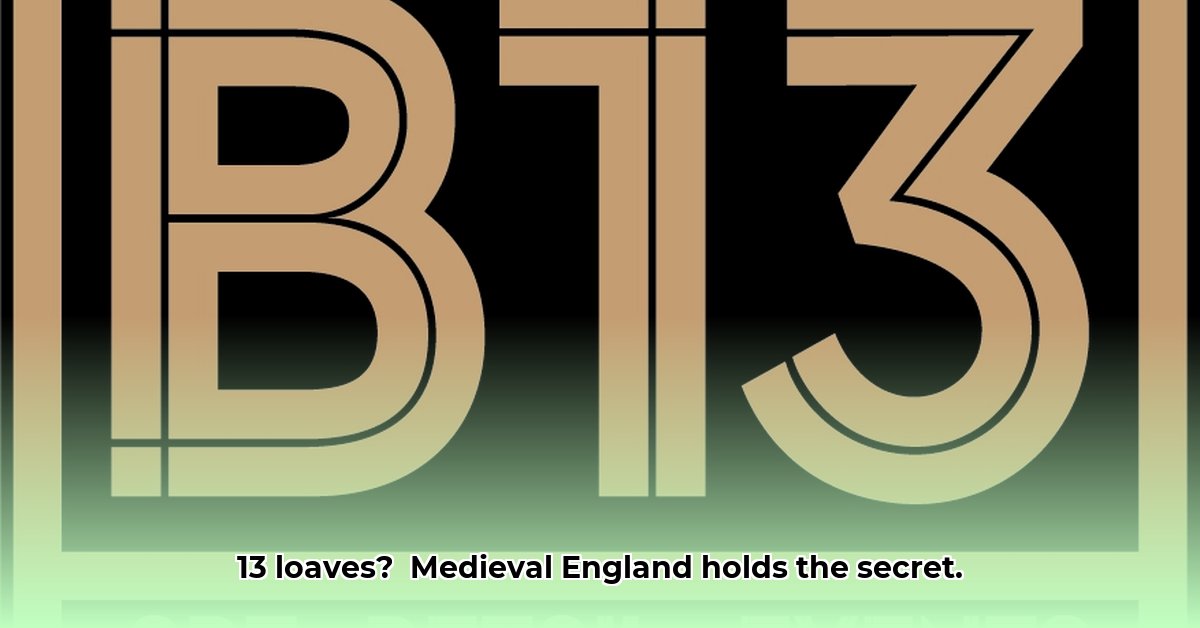Ever wondered why a baker’s dozen is 13 instead of 12? It’s not just a quirky tradition; it’s a fascinating glimpse into history rooted in the strict regulations of medieval England. To understand this system better, learn more about medieval education systems. Bakers once faced severe penalties for selling underweight loaves, leading them to adopt a clever solution: adding an extra loaf to avoid potentially ruinous fines. This wasn’t simply about skirting the law; it evolved into a symbol of generosity and good faith. Join us on a journey back in time to uncover the origins of this enduring custom.
The Medieval Origins of a Baking Tradition
The story of the baker’s dozen begins in medieval England, where baking was a serious business governed by stringent rules and harsh punishments. The Assize of Bread and Ale, a set of laws dating back to the 13th century, dictated the price and weight of bread, a dietary staple for the population. These laws were incredibly specific and fluctuated with the price of wheat making compliance a constant challenge for bakers.
Imagine the life of a medieval baker. They lacked the precision scales and standardized ingredients we take for granted today. Baking was an inexact science, and achieving a consistent weight for every loaf was nearly impossible. Even a slight discrepancy could lead to accusations of shortchanging customers, resulting in hefty fines, public humiliation, or even imprisonment.
Facing the constant threat of punishment, bakers sought a way to protect themselves. Their solution was both simple and ingenious: they added an extra loaf to every order. This “baker’s dozen,” consisting of thirteen loaves instead of twelve, provided a crucial buffer against unintentional errors in weight. The extra loaf served as a form of insurance, ensuring that even if one or two loaves were slightly underweight, the overall weight of the batch would still meet the legal requirement. The Assize of Bread and Ale existed as far back as 1266.
This practice wasn’t initially driven by generosity or a desire to give customers more than they paid for. It was a pragmatic risk-management strategy designed to safeguard bakers from potentially devastating penalties. The baker’s dozen emerged as a direct response to the harsh realities of medieval baking regulations, a testament to the bakers’ resourcefulness and resilience.
Over time, as regulations evolved, the baker’s dozen transformed from a legal necessity into a customary practice. While the strict laws that initially prompted its creation gradually eased, the tradition of giving an extra loaf persisted. It evolved into a symbol of goodwill and generosity, a way for bakers to demonstrate their commitment to customer satisfaction. The baker’s dozen became associated with fairness, abundance, and good old-fashioned value.
While the risk-mitigation theory is the most widely accepted explanation for the origin of the baker’s dozen, other theories have been proposed. Some suggest that bakers charged customers for twelve loaves while providing thirteen, allowing them to earn a slightly higher profit margin and that thirteen loaves fit perfectly on a baking tray. However, these theories lack the strong historical support and contextual evidence that underpin the risk-mitigation explanation, particularly the Assize of Bread and Ale
The story of the baker’s dozen offers a fascinating glimpse into the past, revealing how legal regulations, economic pressures, and cultural norms can shape even the most commonplace traditions. It reminds us that seemingly simple customs often have complex and intriguing histories, waiting to be uncovered and explored.
Here’s a summary to help you digest all the different theories:
| Theory | Explanation | Strength of Evidence | Weaknesses |
|---|---|---|---|
| Risk Mitigation | Bakers added an extra loaf to avoid penalties for unintentionally underweight loaves. | Strong historical evidence derived from the strict laws of the time | Some details concerning the implementation of this practice remain shrouded in uncertainty. |
| Added Profit Margin | Bakers charged for twelve but gave thirteen, increasing their profit margin. | Limited concrete historical support | This theory appears less probable, considering the onerous penalties imposed for offering underweight loaves. |
| Optimal Tray Arrangement | Thirteen loaves fitted best on baking trays. | Minimal to no historical background | This conjecture lacks a historical framework and exists as pure speculation. |
The story of the baker’s dozen isn’t just about numbers; it’s about the lives and challenges of the people who lived in medieval times. It demonstrates how ingenuity, resilience, and the ever-present need to adapt can lead to customs that endure for centuries, enriching our culture and reminding us of our shared history.
Understanding Medieval Regulations and Baking Practices
The baker’s dozen is a delightful quirk of history shaped by medieval England’s stringent baking regulations, delving into the fascinating story of baking laws and the challenges of producing bread, it shows how bakers were affected.
The Assize of Bread and Ale: A Baker’s Nightmare
In the 13th century, the Assize of Bread and Ale was enacted, a set of laws dictating the prices and weights of bread. These weren’t mere suggestions; they were legally enforced, with severe repercussions for non-compliance. Bakers faced immense pressure as wheat prices fluctuated and baking technology remained primitive. The penalties for underweight loaves ranged from substantial fines to public floggings or imprisonment, instilling a climate of fear where a simple error could ruin a baker’s livelihood.
A Thirteenth Loaf: Insurance Against Ruin
To navigate the legal landscape, resourceful bakers adopted a clever strategy: routinely adding an extra loaf. This practice, though not inherently generous, was an insurance policy against penalties for unintentionally producing underweight loaves. The extra loaf served as a buffer, providing a margin of safety in a system that offered none.
From “Inbread” to “Baker’s Dozen”: A Linguistic Shift
Initially, the extra loaf was known by various names, such as “inbread” or “vantage loaf.” Over time, however, the practice became standardized, evolving into the now familiar “baker’s dozen.” This linguistic evolution signifies societal acceptance of the practice, transforming it from a risk-mitigation strategy into a established commercial custom and highlighting the profundity in how regulations can permeate our culture.
Beyond the Thirteenth Loaf: Variations and Uncertainties
While the narrative of the baker’s dozen as a direct response to the Assize of Bread and Ale is largely accepted, nuances remain debated. It’s unclear whether the extra loaf always equated to a full-sized loaf, and variations occasionally led to fourteen items, such as whether it was always strictly 13 items, or did variations occasionally lead to 14? While these details can be debated, the core reason for the tradition’s emergence remains undisputed. The medieval baking laws created a high-risk environment where adding an extra loaf was a practical necessity.
The Enduring Legacy: A Cultural Curiosity
The “baker’s dozen” survives today as a cultural curiosity, reminding us of the challenges faced by medieval bakers and the ingenuity they employed to navigate a heavily regulated and high-stakes profession. Receiving an extra item reflects a fascinating intersection of law, business, and culinary history, celebrating the human spirit’s ability to adapt.
Key Takeaways:
- The baker’s dozen originated as a risk-mitigation strategy for medieval bakers.
- Strict regulations under the Assize of Bread and Ale pressured bakers to produce loaves of precise weight.
- The extra loaf served as insurance against harsh penalties for underweight loaves.
- The term “baker’s dozen” evolved from earlier terms like “inbread” or “vantage loaf.”
- Despite some minor variations in practice, the core reason for its existence remains undisputed.
Strict Laws Shaped Pricing Strategies in Medieval Times
Medieval Baking Laws & The Baker’s Dozen’s Impact on Pricing Strategies helped form our understanding of historical economics.
Key Takeaways:
- The baker’s dozen wasn’t about generosity; it was about survival.
- Strict medieval bread laws severely punished any weight and measurement discrepancies.
- Adding an extra roll was a way to avoid hefty fines ensuring against potential ruin.
- The practice evolved into a marketing tactic and influenced medieval pricing strategies.
A Loaf of Bread and the Price of Justice
Imagine medieval England, where food was paramount, and bread reigned as the ultimate staple. Baking was governed by strict regulations, primarily the Assize of Bread and Ale (1266). This legislation meticulously outlined bread weight and price based on the fluctuating cost of wheat. Why such strictness? Shortchanging customers meant denying them sustenance, a serious offense punishable by steep fines, public humiliation, or imprisonment. For a baker, accurate weight meant prosperity and freedom. What role did the Assize of Bread and Ale play in the lives of bakers?
A Baker’s Gamble: The Risky Business of Breadmaking
Medieval baking was far from precise due to temperamental ovens, non-standardized ingredients, and rudimentary measuring tools. Bakers could easily produce a loaf slightly lighter than legally mandated without realizing it, making compliance a constant source of stress. It was a gamble every time the oven door opened.
The Extra Loaf: A Safety Net
Bakers developed a clever solution: the “inbread” or “vantage loaf,” an extra loaf added to each order as a safeguard against falling short of the legal weight requirement. This wasn’t altruism but risk management. This practice eventually solidified into the baker’s dozen. While numbers varied, the core principle remained better safe than sorry. How effective was this strategy in protecting bakers?
From Risk Mitigation to Marketing
Over time, the baker’s dozen transformed from a necessity to a marketing tool, highlighting a baker’s commitment to quality and exceeding expectations. This subtly signaled to consumers that the baker cared about delivering value, building trust and loyalty in a world without easy verification of weights and measures. Did this transformation change public perception?
The Baker’s Dozen: A Legacy of Law and Loaf
The baker’s dozen reminds us that seemingly simple traditions often have surprising origins rooted in historical context and economic realities. The seemingly generous gift of an extra roll is a fascinating artifact of medieval England’s stringent food laws and the inherent unpredictability of bread-making, illustrating how regulations can inadvertently shape cultural practices.
The Evolution: From Legal Requirement to Tradition
Explore the cultural impact of the Baker’s Dozen’s Cultural Evolution: From Legal Obligation to Marketing Tactic, which originally stemmed from a legal system.
The Weight of the Law
Medieval bakers faced incredibly strict regulations. The Assize of Bread and Ale, implemented in 1266, meticulously controlled bread weight and price. Shortchanging customers meant serious consequences – hefty fines, physical punishment, even imprisonment. Baking had to ensure each loaf met the precise weight standards or pay a steep price. What were these laws called, and how strictly were they enforced?
A Baker’s Clever Solution
Given the imprecise tools available, maintaining perfect weights was a gamble. Slight variations could affect the final loaf weight. The solution? A genius stroke of risk mitigation as the bakers started including an extra roll or loaf, significantly reducing their chance of legal trouble. How did they measure flour weights back then?
From “Inbread” to “Baker’s Dozen”
This extra loaf wasn’t initially called a “baker’s dozen.” Early terms describe this as “inbread” or a “vantage loaf,” reflecting its initial purpose as a safety net. The transition testifies to the practice’s evolution during 1599. The term “baker’s dozen” evolved around 1599, reflecting a societal shift towards its acceptance.
Evolving Traditions
Over time, the Baker’s Dozen’s Cultural Evolution: From Legal Obligation to Marketing Tactic became less about avoiding fines and more about a customary practice and becoming a part of the expected exchange. The baker’s generosity, once a shield against punishment, transformed into a positive brand image. At what point did it become more custom than necessity?
A Modern Marketing Tool
Today, the “baker’s dozen” is often used as a promotional tool for businesses to leverage the historical connection, and enhance customer experience. It represents a complete reimagining of its original purpose, almost ingrained in our society.
Alternative Theories: A Nuanced History
While avoiding legal repercussions is the dominant theory, other explanations exist. Some suggest the extra item was a form of profit sharing with vendors or that bakers found baking in batches of 13 more efficient, because of the geometry of their baking trays. But, the weight-regulation theory remains the most compelling explanation. Which theory is the most convincing and why?
Key Takeaways:
- The baker’s dozen originated from the strict weight regulations of medieval England.
- The practice reduced the risk of penalties for underweight loaves.
- The term “baker’s dozen” evolved from earlier terms like “inbread” or “vantage loaf”.
- The practice transitioned from a legal necessity to a customary tradition.
- Modern businesses now use it as a marketing strategy.
- Discover the best books on ancient Roman history: Expert recommendations for all levels - August 6, 2025
- Why is the Sky Blue? The Simple Answer: Atmospheric Optics Revealed - August 6, 2025
- Unlock Ancient History Books: New Discoveries, 2025 - August 6, 2025
















